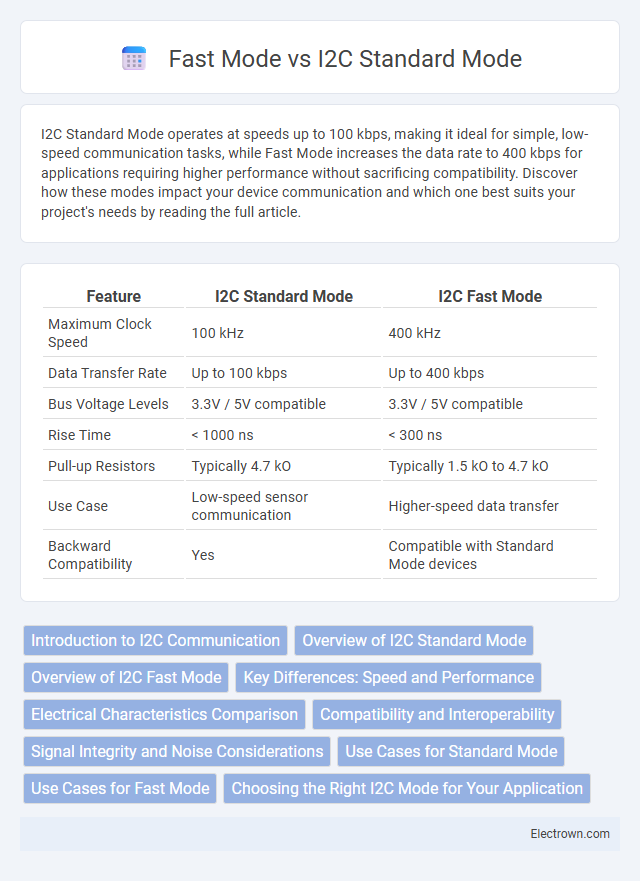I2C Standard Mode operates at speeds up to 100 kbps, making it ideal for simple, low-speed communication tasks, while Fast Mode increases the data rate to 400 kbps for applications requiring higher performance without sacrificing compatibility. Discover how these modes impact your device communication and which one best suits your project's needs by reading the full article.
Table of Comparison
| Feature | I2C Standard Mode | I2C Fast Mode |
|---|---|---|
| Maximum Clock Speed | 100 kHz | 400 kHz |
| Data Transfer Rate | Up to 100 kbps | Up to 400 kbps |
| Bus Voltage Levels | 3.3V / 5V compatible | 3.3V / 5V compatible |
| Rise Time | < 1000 ns | < 300 ns |
| Pull-up Resistors | Typically 4.7 kO | Typically 1.5 kO to 4.7 kO |
| Use Case | Low-speed sensor communication | Higher-speed data transfer |
| Backward Compatibility | Yes | Compatible with Standard Mode devices |
Introduction to I2C Communication
I2C communication enables efficient short-distance data exchange between microcontrollers and peripherals using two bidirectional lines: SDA (data) and SCL (clock). Standard Mode operates at data rates up to 100 kbps, while Fast Mode enhances transmission speeds to 400 kbps, improving performance in applications requiring quicker data transfer. Both modes support multi-master and multi-slave configurations with built-in arbitration and clock synchronization for robust communication.
Overview of I2C Standard Mode
I2C Standard Mode operates at a clock speed of up to 100 kHz, providing reliable communication for devices with moderate data transfer requirements. This mode supports multi-master and multi-slave configurations, making it versatile for various embedded systems. Your design benefits from Standard Mode's low power consumption and simplicity, ideal for sensor interfacing and low-speed peripherals.
Overview of I2C Fast Mode
I2C Fast Mode operates at speeds up to 400 kHz, significantly increasing data transfer rates compared to the Standard Mode's 100 kHz limit. This mode uses tighter timing specifications and improved signal integrity to support faster communication between microcontrollers and peripherals. Your embedded system benefits from reduced latency and enhanced throughput when utilizing I2C Fast Mode for high-speed sensor or memory interfacing.
Key Differences: Speed and Performance
I2C Standard Mode operates at speeds up to 100 kbps, making it suitable for basic communication in low-speed applications, while Fast Mode increases the data transfer rate up to 400 kbps, significantly improving performance in more demanding environments. The higher speed of Fast Mode enhances your device's efficiency by reducing transfer times and allowing quicker data exchange between components. Choosing between these modes depends on the required speed and performance levels of your specific application.
Electrical Characteristics Comparison
I2C Standard Mode operates at a maximum clock frequency of 100 kHz with a typical rise time of 1000 ns, while Fast Mode increases the clock frequency up to 400 kHz and reduces the rise time to 300 ns, enabling quicker data transfers. The bus capacitance in Standard Mode supports up to 400 pF, whereas Fast Mode can accommodate up to 400 pF but demands stronger pull-up resistors to maintain signal integrity at higher speeds. Both modes utilize open-drain/open-collector outputs with defined voltage levels of 0.3*VDD for low and approximately VDD for high, but Fast Mode requires stricter timing constraints to ensure reliable communication over the I2C bus.
Compatibility and Interoperability
I2C Standard Mode operates at speeds up to 100 kbps, ensuring broad compatibility with legacy devices and established microcontrollers. Fast Mode increases data rates to 400 kbps, enhancing performance while maintaining backward compatibility with Standard Mode devices through stricter timing requirements and signal integrity. When designing your system, choosing Fast Mode can significantly improve communication speed without sacrificing interoperability across a wide range of I2C-compatible peripherals.
Signal Integrity and Noise Considerations
I2C Standard Mode operates at speeds up to 100 kbps, offering better signal integrity and reduced noise susceptibility due to slower rise and fall times, which minimizes signal distortion on long or noisy lines. Fast Mode increases the clock speed to 400 kbps, enhancing data throughput but requiring better PCB layout, stronger pull-up resistors, and noise reduction techniques to maintain signal integrity and prevent data corruption. Your design must carefully balance speed requirements with noise considerations to ensure reliable communication in both modes.
Use Cases for Standard Mode
Standard Mode I2C operates at speeds up to 100 kbps, making it ideal for applications requiring reliable communication with low power consumption, such as sensor data acquisition and real-time clock interfacing. Its slower speed ensures signal integrity and compatibility with a wide range of peripheral devices, frequently found in embedded systems and microcontroller-based projects. Your choice of Standard Mode supports stable and energy-efficient data transfer in environments where speed is less critical than accuracy and device compatibility.
Use Cases for Fast Mode
Fast Mode I2C operates at speeds up to 400 kHz, making it ideal for applications requiring quicker data transfer such as audio equipment, LCD displays, and real-time sensor data acquisition in industrial automation. This mode enhances performance in environments where multiple devices communicate on a single bus without compromising signal integrity or increasing power consumption significantly. Fast Mode's improved speed supports efficient communication in complex embedded systems and consumer electronics demanding rapid data exchange.
Choosing the Right I2C Mode for Your Application
Choosing the right I2C mode depends on the required data transfer speed and power consumption constraints. Standard Mode supports up to 100 kbps and is suitable for low-speed, low-power sensor applications, while Fast Mode enables speeds up to 400 kbps, ideal for data-intensive tasks requiring quicker communication. Evaluating device compatibility and bus capacitance is crucial to ensure reliable performance in your chosen I2C mode.
I2C Standard Mode vs Fast Mode Infographic

 electrown.com
electrown.com